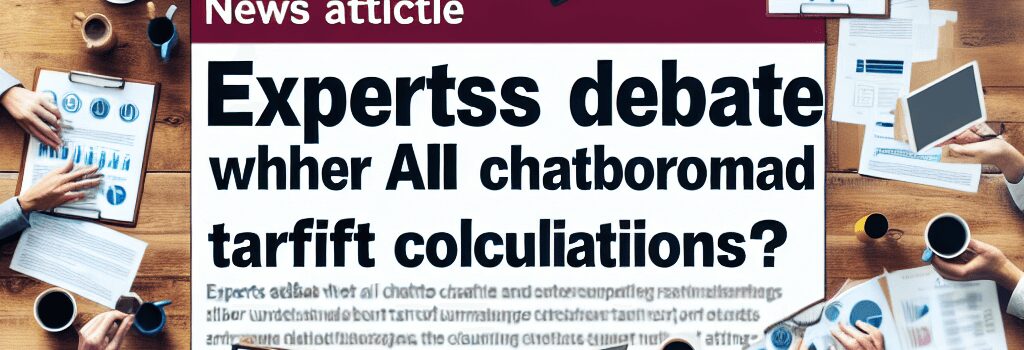Did AI Chatbots Influence Trump’s Tariff Decisions?

Overview
Recent controversy has arisen over the method used by the Trump administration to calculate reciprocal tariffs. Critics argue that the seemingly oversimplified and arguably flawed math behind tariffs for over 60 countries might have been influenced by automated outputs—possibly even those generated by AI chatbots. The tariffs, set to begin on April 5 with a baseline rate of 10 percent and peaking at around 50 percent on April 9 for certain countries, were targeted at nations with the largest trade deficits against the United States.
Among the baffling entries in the tariff list are uninhabited islands, which despite being home to wildlife like penguins, register no significant exports to the United States. These peculiarities have only deepened questions regarding the origin of the underlying data and whether automated tools, such as ChatGPT, Gemini, Claude, or Grok, might have inadvertently contributed to the proposed tariff formula.
Tariff Calculation Methods Under Scrutiny
Economists and trade experts have closely examined the calculation method used by the administration. Instead of taking into account a comprehensive overview of international trade dynamics, the approach appears to focus solely on the trade deficit in goods, omitting the surplus in service sectors. As noted by economist James Surowiecki on X (formerly Twitter), the administration’s formula involves dividing the goods-based trade deficit by the exporting country’s trade volume to the US. Surowiecki described this simplified method as not only “dumb and deceptive” but also dangerous in potentially triggering unforeseen economic consequences, including sudden price hikes for American consumers and businesses.
- Data Integrity: Economic analysts emphasize that neglecting the service sector can misrepresent actual bilateral trade dynamics.
- Complexity of Trade Metrics: True trade balances account for a complex interplay of non-tariff barriers and qualitative factors that are not easily computed by basic arithmetic.
- Risks of Automation: Using automated tools without proper oversight could lead to oversights and anomalies, such as tariffs on geographically insignificant or uninhabited territories.
Rumors of Chatbot Involvement and Expert Opinions
Social media has been rife with speculation that the Trump administration might have relied on chatbot-generated data for these calculations. Screenshots shared on platforms like Bluesky reveal that several widely used chatbots—ChatGPT, Gemini, Claude, and Grok—offer similar simplified methods when prompted with phrases reminiscent of the administration’s public statements on tariffs. These chatbots also issued disclaimers about oversimplifying the complex nature of international trade.
For example, ChatGPT explicitly noted that its shortcut method “ignores the intricate dynamics of international trade.” Similarly, Gemini and Claude warned that trade deficits alone do not constitute unfair trade practices and that tariffs have multifaceted economic impacts, such as the potential for retaliatory measures and cascading price increases. Such insights underscore the importance of employing nuanced, multi-factorial analytical tools rather than relying on rudimentary ratio calculations.
Technological Underpinnings and AI in Policy Making
The notion that an AI tool might indirectly influence national economic policies is both intriguing and alarming. Modern chatbots are powered by sophisticated machine learning algorithms that draw upon vast datasets and computational models. When these systems generate outputs based on historical data and user prompts, they can sometimes converge on simplified solutions that might not account for new economic variables, regulatory nuances, or emerging global trends.
Moreover, the potential use of chatbots in high-stakes policy analysis raises questions about data integrity and the need for human oversight. Government agencies leveraging AI must balance the speed and efficiency of automation with the accuracy that comes from expert analysis.
Deeper Analysis: Economic and Technical Perspectives
Several experts have pointed out that while AI and machine learning models can provide preliminary forecasts or simulations, they must be complemented by rigorous, domain-specific econometric analysis. The current controversy highlights a broader issue that many policymakers face: the tension between leveraging cutting-edge technology and ensuring that traditional economic complexities are not oversimplified.
A deeper technical examination reveals that any tariff model should incorporate the following components:
- Multi-Sector Analysis: Integrating data from both goods and service sectors to reflect the holistic nature of trade relationships.
- Non-Tariff Barriers: Including factors such as import quotas, subsidies, and regulatory constraints that affect trade flows.
- Dynamic Modeling: Utilizing time-series analysis and machine learning to adjust parameters based on real-time global economic shifts.
- Scenario Simulations: Running simulations to forecast the short-term and long-term impacts of tariff implementations on both domestic markets and international trade partners.
Looking Ahead: Implications and Future Policy Directions
Critics argue that this automated approach—or at least an approach inspired by chatbot outputs—may oversimplify highly complex trade relationships, leading to policies that could inflict collateral damage on American businesses and consumers. With rising concerns over economic repercussions, the Trump administration faces mounting pressure to substantiate its model with robust, verifiable data that goes beyond simplistic arithmetic.
As discussions continue among policymakers, economists, and technology experts, there is a growing consensus on the urgent need for more sophisticated tools that can bridge the gap between computational efficiency and economic complexity. The debates also point to a future where AI plays an increasingly important role in policy development, provided its outputs are carefully contextualized by subject matter experts.
In the coming months, further clarifications from trade officials and additional technical audits will likely shed more light on whether AI chatbots contributed to the tariff model, and if so, how to better harness AI in formulating future economic policies that protect and promote sustainable growth.
Conclusion
While rumors about chatbot involvement in the Trump administration’s tariff calculations remain unconfirmed, the controversy has opened a broader conversation on the intersection of AI and economic policy. As both technology and global trade continue to evolve, the necessity for precise, comprehensive modeling becomes more critical than ever—all while ensuring that automation does not undermine the nuanced realities of international commerce.